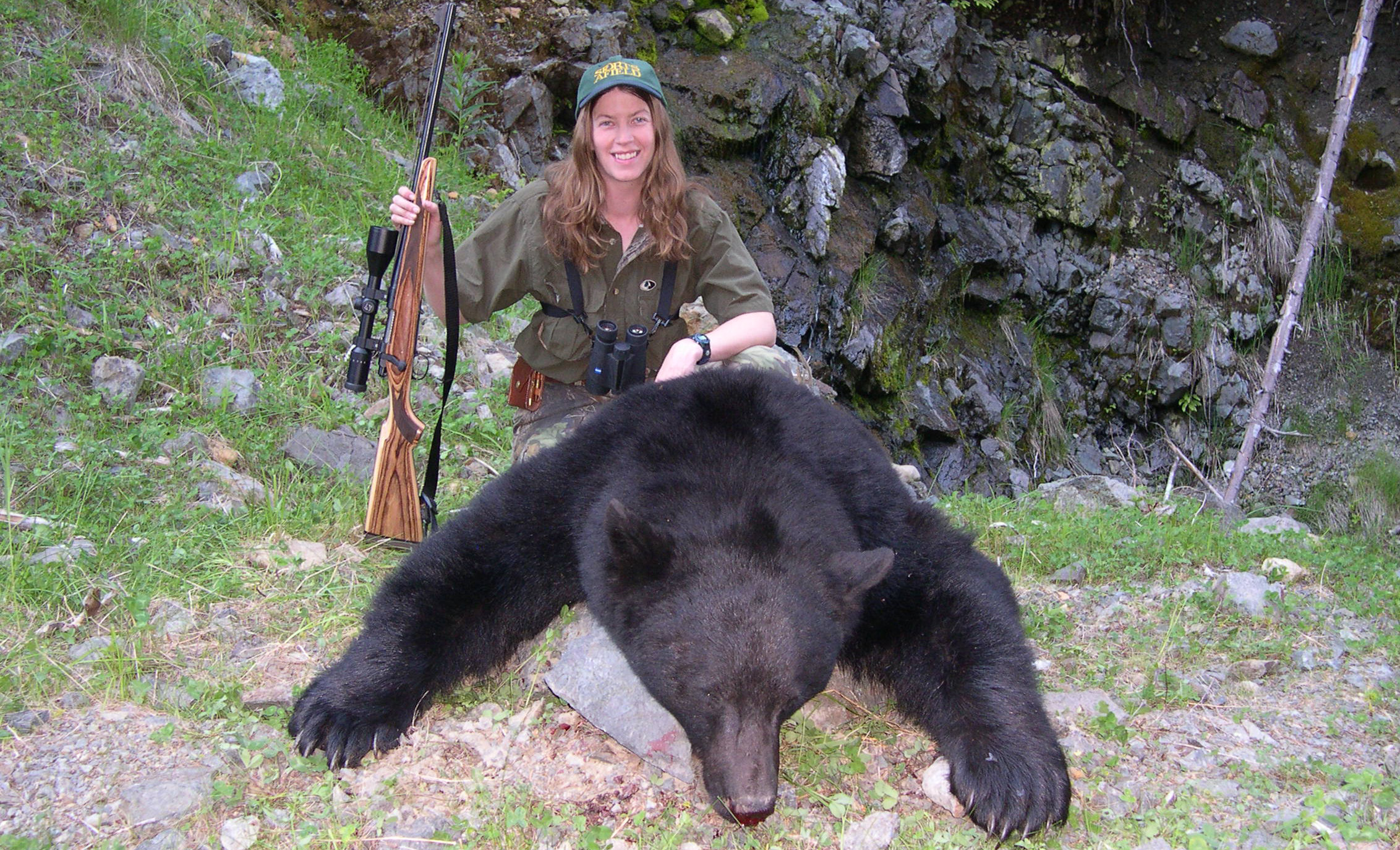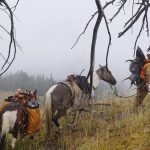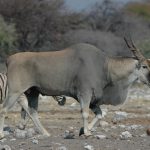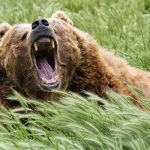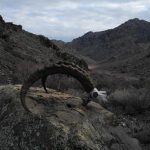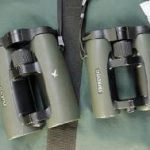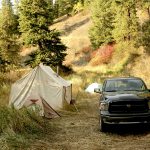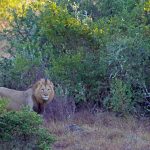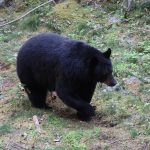Face to face with black bear on the West Coast’s largest island.
When we first spotted the huge black bear, it was lumbering down the slope onto a high plateau that had been clear-cut years before. The cut was regenerating with a mixture of high brush and small trees, and the bear had moved out of the heavy, dark timber on the hillside and was walking across the opening in the cool of the morning. It was moving with a purposeful, rolling gait like a fat man on his way to a bar, and even at more than half a mile away, the bear looked big.
Kim Cyr, my guide, studied the bear through his binocular and seemed to get more excited as the minutes passed. “That’s a four-ear bear,” he finally said in a low, awed tone. “Twenty inches, plus.”
Kim had spent the past couple of days coaching me on how to judge a big bear since I’d told him that, frankly, every bear looked huge to me. Kim explained that one of the tricks to judging a particular bear’s skull size was to look at it as it was facing you and figure out how many imaginary ears you could place between the bear’s actual ears. The more ears, the wider the skull and (presumably), the older and larger the bear. Three ears was a shooter. Three and a half was huge. Four . . . we hadn’t even discussed four. Four would be a monster.
I stared, but the bear was moving through the brush and I had trouble getting a good look at its head. I fixed its direction of travel in my mind and lowered the binocular. A grassy, brush-lined, grown over logging road snaked along the edge of the clear-cut. The bear was angling toward it.
“We could sneak up that road and maybe get a shot,” I suggested.
Kim was already getting to his feet. “We’ll take it slow, and try to stay out of sight,” he said. “The bear’s probably heading for the road to feed on some of that grass, so he’ll be there for a while.”
As we catfooted our way up the old road, the breeze blew directly in our faces. The track curved just enough so that the brush along its side shielded us from the bear’s view. As the sun kissed the mountain peaks, the low booming of blue grouse provided an occasional background bass note. I couldn’t believe it: On the third day of my Vancouver Island black bear hunt, with one of my two bear tags already filled, I was stalking a Boone-and-Crockett-class bear under ideal conditions: easy, quiet walking, perfect wind, and good cover.
We took more than an hour to move three-quarters of a mile up the old read, exercising great caution with every step since we couldn’t see the bear’s exact location. I spent the last fifteen minutes on hyper-alert, expecting the bear to step onto the road in front of us at any moment. I’d cranked the scope on my .308 down to its lowest power. Suddenly I froze in place, staring at a tree limb as it moved unnaturally up and down, pulled by the feeding bear on the other side. We had closed the distance to less than twenty yards. The wind was still in our faces, and the bear couldn’t see us as it fed behind the screen of brush and trees. The problem was, I couldn’t see it either. Ever so slowly, I edged across the road, trying for a clear field of view.
Finally I could see the bear, but only its top half. It was intent on feeding, but I hated to shift position at such point-blank range. Even a nearsighted bear would spot my movement.
Kim whispered urgently from behind me: “Shoot!”
Through the scope, only the bear’s back and the upper part of its chest was visible. The rest of the bruin was hidden behind a round, white log. Fearing to shoot too high, I held the cross hairs as low on the chest as I could—just above the log—and touched off the shot.
Confusion reigned after the rifle’s report echoed across the plateau. I worked the bolt and tried in vain to get the bear in my scope again as it whirled and sped across the clear-cut astoundingly fast for an animal of its size, disappearing behind a rise. When it was gone, we looked hard for signs of a hit and found none. The day before, I had killed a much smaller bear at a hundred and eighty yards, so I couldn’t imagine how I could have missed the huge one at twenty.
“You didn’t shoot the log, did you?” Kim asked, at last.
With sinking heart, I walked over to the fallen log. I traced the deep groove cut through it by my bullet and visually followed the shot’s deflection into the soft ground.
I fumed at myself for not thinking. Naturally, at such close range, the path of the bullet would have been a couple of inches lower than my cross hairs indicated. The difference should have been obvious, but it hadn’t occurred to me before the shot. But then I had never expected spot-and-stalk bear hunting to be such a heart-pounding, close-range game.
“We’ll find another bear,” said Kim, encouragingly. Then he added wistfully, “But that one was really big.”
Black bears are found across the continent from Maine to Arizona, from Florida to Alaska. The Boone and Crockett record book lists almost as many huge bears coming from southern California as from northern Pennsylvania, and from many places between and beyond: Minnesota, Alaska, Utah, Newfoundland. I’ve watched bears tearing up rotten logs on the Allegheny Plateau, gnawing on deer carcasses in Canada, and munching spring flowers in Montana meadows.
Many of the places bears live, especially in the East, are heavily forested, and that makes them tough to hunt. You have to hunt over bait, use dogs, organize a drive, or wander around the woods and hope you happen to see one. That’s why I like hunting bears out West, where they emerge from the heavy timber into meadows and clear-cuts and you can spot them and stalk them in some of the most scenic surroundings imaginable.
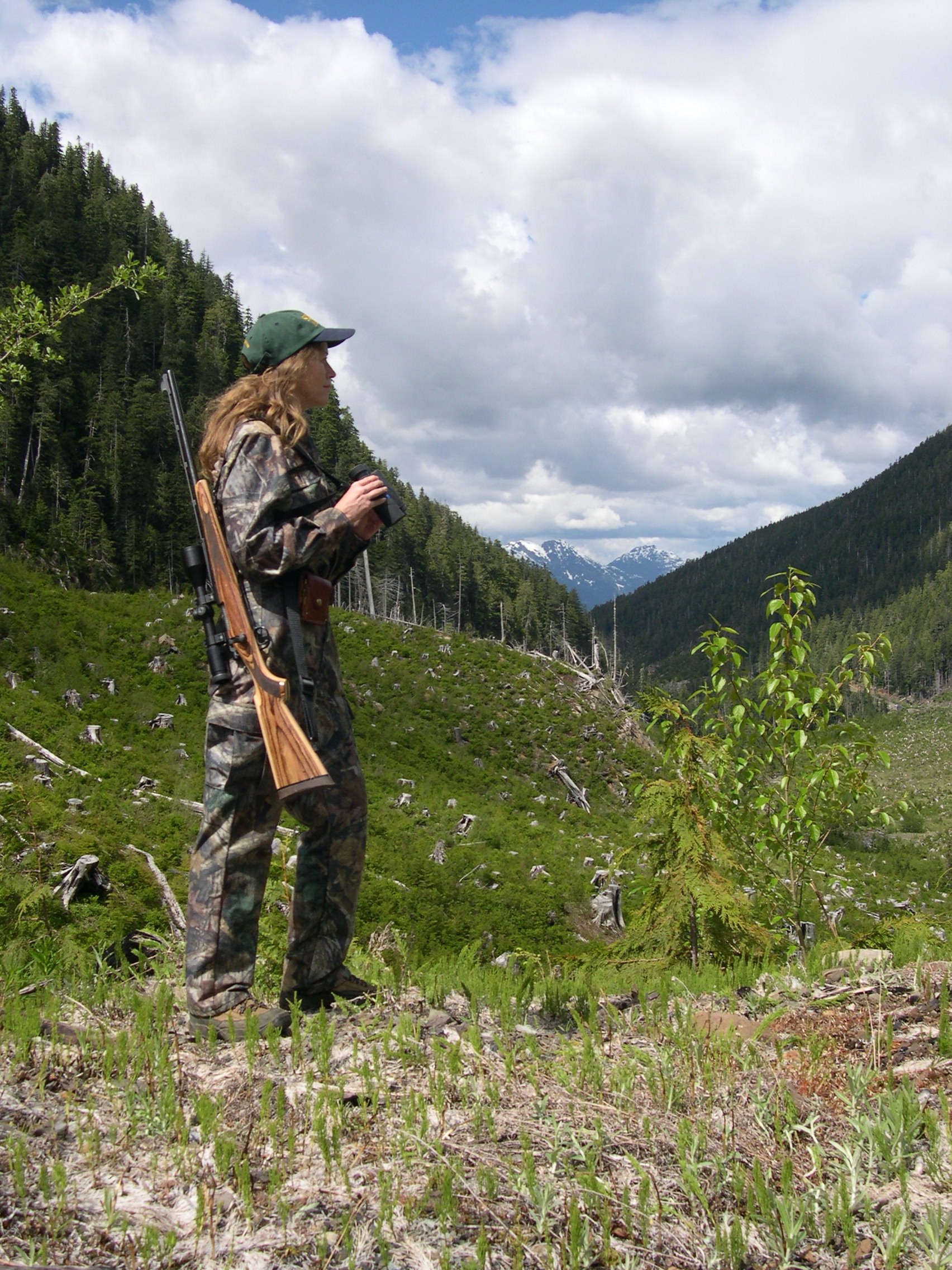
I’d done that before, but never on Vancouver Island, where “scenic” is taken to the extreme. V.I. is covered with thick forests of tall firs carpeting five-thousand-foot mountain peaks that soar straight up from sea level. In late May, those peaks are still snowcapped, with skinny fingers of waterfalls pouring off the cliffs and crashing into snowfields below. The dark forests are checkered with huge clear-cuts that are in turn crisscrossed by old logging roads. The clear-cuts make it possible to spot and stalk the many bears on the island. We saw several bears every day, moving along the creek bottoms, feeding in clear-cuts, and moving up hillsides to bed down in the heavy timber.
And it’s not just that bears are numerous on V.I. They also get big there. There’s no shortage of food in this ursine Utopia, and bears take full advantage of all of it. After their craving for spring grass wears off and summer moves toward fall, they’ll move on to gorging on berries in the slashings, gulping steelhead and salmon in the streams, and even munching crabs on the beaches.
The area I was hunting provided plenty of ground to cover, too. Outfitter Darren DeLuca is the son-in-law of legendary V.I. outfitter Wayne Wiebe, the man who originally put the island on the map as a major bear-hunting destination. DeLuca, an experienced guide-outfitter in his own right, has some two thousand square miles of forests, mountains, and clear-cuts for his hunters to explore, stretching from Herbert Inlet on the northwestern side of the island to Alberni Inlet near the town of Port Alberni on the southeast.
Typically, bear hunters drive the logging roads, glassing, spotting bears, and stalking to within a couple hundred yards for the shot. But many of the roads have been closed to vehicles and seeded, and hunters can also sneak along these tracks watching for bears. That’s what Kim and I had been doing, often encountering bears at less than fifty yards as they foraged in the new grass along the old roads.
Black bears may be ubiquitous, but that doesn’t make them less deserving of respect. It’s true they’re rarely aggressive, but as soon as a bear feels threatened or cornered, it’s capable of wiping that smile off your face in a hurry. So if you’re still-hunting where bears tend to appear in front of you at point-blank range, it pays to stay alert and keep a shell in the chamber.
As the remaining days of my hunt ticked down, Kim and I continued to hunt hard. I saw the waterfalls getting wider, pitching down from the sheer peaks as the spring melt really got underway, and black-tailed deer fed on the new growth along the edges of the clear-cuts. Teal bobbed in small mountain ponds, and hummingbirds zipped around newly grown wildflowers. Spring in the coastal mountains of British Columbia is exhilarating, and for a bear hunter, each new day holds particular promise.
The last evening of the last day of a memorable hunt always seems bittersweet, especially if you’ve still got a tag to fill. I was hoping for another bear, but I also wanted to burn into my memory the look of the jagged peaks and the tall firs, and the way the air smelled like a combination of sea air and pine forest.
Kim and I left the truck at the base of another old logging road, one that snaked up a narrow ravine cut by a raging, ice-cold stream. We’d hunted this same road several times and had seen bears attracted to the green grass that carpeted the long-unused track. At one point we’d even crossed the roaring creek on wet, lichen-covered rocks to look for bear farther up the mountain. This evening, though, we decided to still-hunt along the twisting road as the sun slid toward the west and the end of my stay on Vancouver Island.
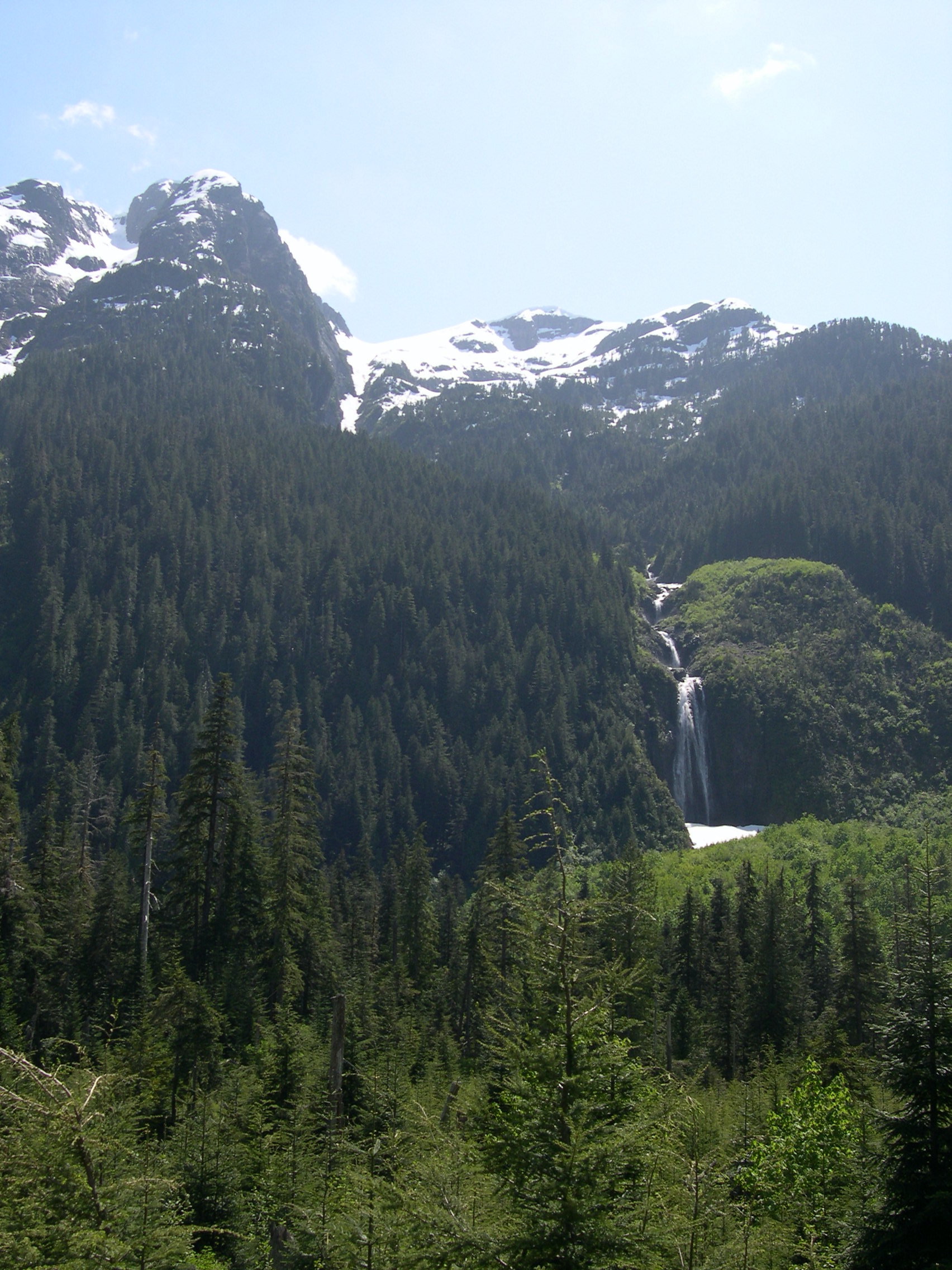
The road climbed through an area that hadn’t been cut, and the big firs loomed close on either side of the road. Clusters of alder brush, devil’s club, and yellow broom grew along the sides of the grassy track. Now and then Kim pointed silently to a bent-over, broken-off alder sapling, and once we stopped to stare in astonishment at a particularly large one that had obviously been torn and gnawed by an enormous bear. Piles of huge, fresh scat littered the road. I settled my boot down carefully with every step, trying to keep the noise of my footfalls to a minimum.
As we eased around a sharp bend, we spotted a big bear just ahead, working its way in our direction through the trees just above the road. It hadn’t seen us, so we dropped down quickly behind an enormous log that lay beside the old road. With my earlier failure fresh in my mind, a solid rest and an unobstructed shot were my immediate priorities. I knelt behind the log, settled the .308 across it, and watched the bear. It was big-bodied and beautifully furred, and as it turned to glance in our direction I saw that there was room for at least three imaginary ears across its skull.
The bear picked its way through the trees, then started down the bank onto the road, heading for our side. Determined to take no risks with the shot, I waited for a broadside angle. My single 180-grain Core-Lokt Ultra round center-punched the bear’s shoulder at 45 yards. The effect was immediate: The bruin simply sank to the ground and rolled onto its back, paws up.
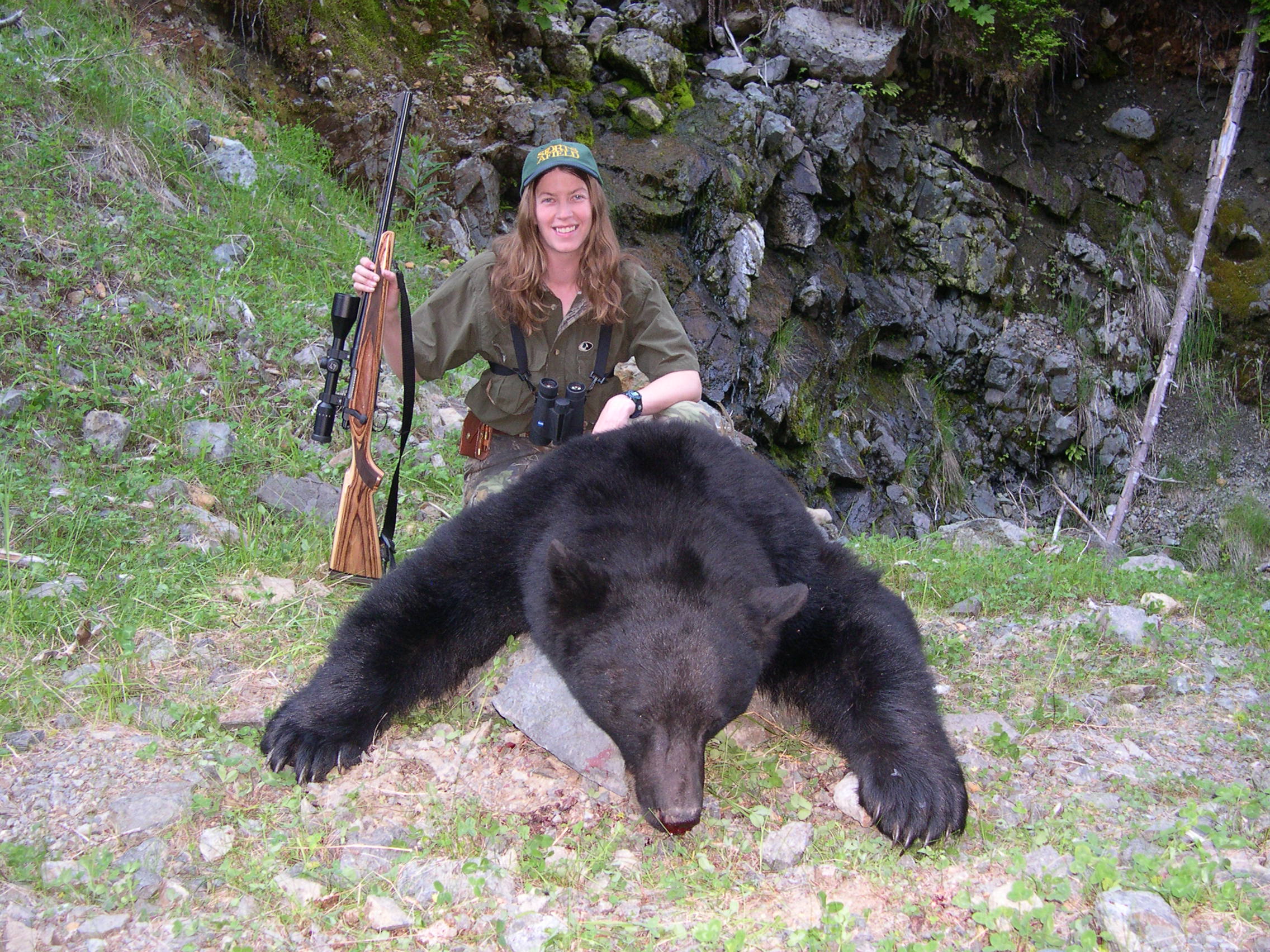
It was a fantastic bear, a massive old bruin with a beautifully furred hide that squared 6 feet, 6 inches, and a skull that was later officially measured at 18¼ inches. After skinning and quartering, Kim lashed the hide and most of the meat to his packframe. I slid the remaining hindquarter into my pack, secured the rest of my gear on top of it, and hoisted the load onto my back. Heavily laden but happy, we hiked back down the old road in the gathering dusk. The tall peaks of Vancouver Island glowed like church spires against the setting sun, appropriate monuments to honor a magnificent animal.
Contact Darren DeLuca, Vancouver Island Guide Outfitters: 250-724-1533, [email protected]; or visit HuntWild.com.

